Driveway Shapes – Unleash Curb Appeal with 11 Design Ideas
When considering a new driveway, the shape you choose can significantly impact your property’s curb appeal and functionality. Driveway shapes vary widely, offering each homeowner the chance to find the perfect match for their home and lifestyle.
Driveway shapes range from the straightforward straight and curved designs to more intricate forms like circular, semi-circular, U-shaped, L-shaped, S-shaped, and Y-shaped driveways. There are also wide, custom, serpentine, and teardrop options for those looking for something unique. Each shape has its benefits, from enhancing aesthetic appeal to improving traffic flow and maximizing space.
For more insights on how each driveway shape can complement your property and meet your specific needs, keep reading.
11 Popular Driveway Shapes and Their Benefits
Choosing the right driveway shape is not just about aesthetics; it also impacts functionality, ease of navigation, and the overall flow of your property. Here are 11 popular driveway shapes and their unique benefits:
1. Straight Driveway
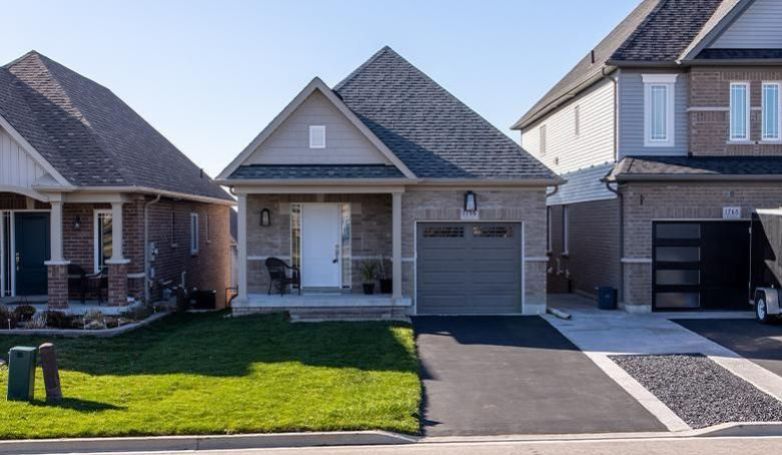
This type of driveway offers a direct route from the street to the garage or parking area, making it highly efficient for daily use. Its uncomplicated design also means lower construction costs and easier maintenance.
Straight driveways are ideal for properties with limited space or those that favor a minimalist aesthetic, providing a clean and unobstructed path that enhances the home’s curb appeal.
2. Curved Driveway
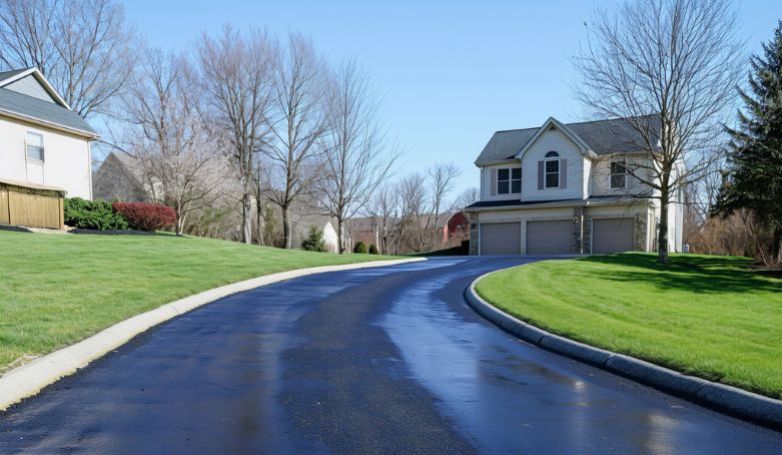
A curved driveway introduces an element of sophistication to any property. Designed to meander gently around natural landscapes, trees, or architectural features, curved driveways create a welcoming approach to the home. This shape can also increase the driveway’s length, providing more space for vehicles and reducing the slope on hilly terrains.
Curved driveways are perfect for adding character to the property while improving functionality and maximizing the use of available space.
3. Circular (or Loop) Driveway
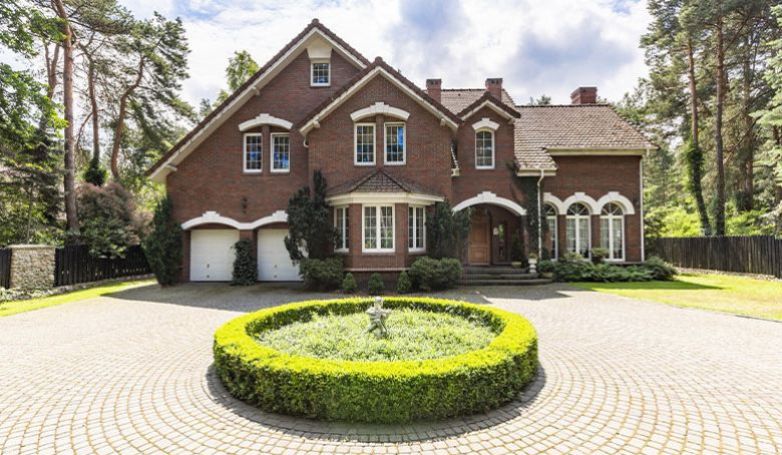
Circular driveways, often referred to as loop driveways, offer exceptional convenience by allowing vehicles to enter and exit without the need to back up. This driveway shape is particularly beneficial for properties with busy or difficult-to-navigate streets.
Beyond practicality, a circular driveway can serve as a grand entrance to your home, significantly enhancing its curb appeal and providing a focal point for front-yard landscaping.
4. Semi-Circular Driveway
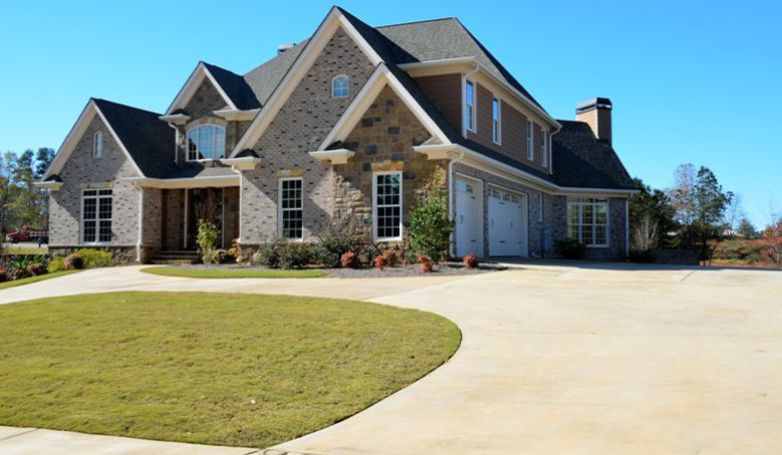
The semi-circular driveway shares many benefits with its circular counterpart but requires less space. This design is ideal for properties that aim to achieve an elegant entrance without the extensive land use of a full circular driveway. It facilitates easy vehicle maneuvering and adds aesthetic value to the home’s frontage.
Semi-circular driveways are also versatile, fitting well with various architectural styles and property layouts.
5. U Shaped Driveway
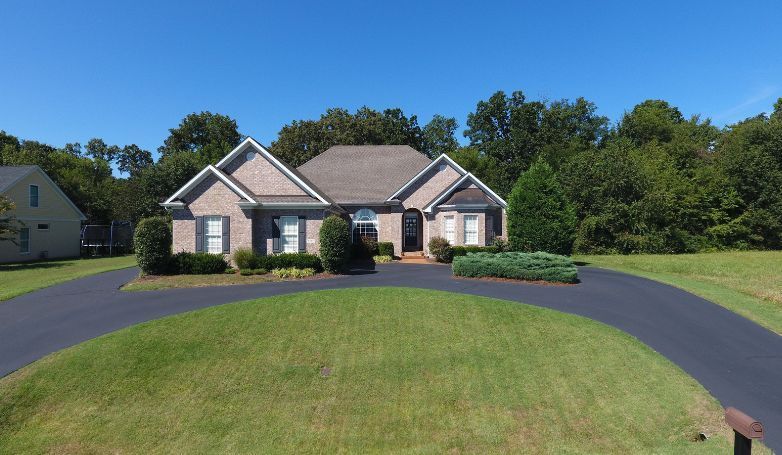
U-shaped driveways are highly functional, providing seamless access to the front door or garage from two entrance points. This shape is particularly useful for properties with multiple buildings or frequent visitors, as it allows for efficient traffic flow and ample parking space.
The U-shape also encloses a portion of the yard, creating a private and inviting courtyard effect that can be landscaped for added beauty and privacy.
6. L Shaped Driveway
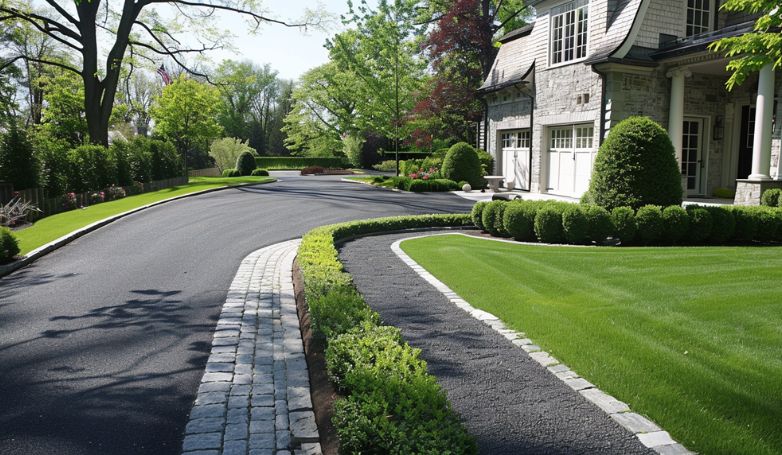
Tailored for corner lots or properties with unique layouts, the L-shaped driveway offers flexibility in design and use. It connects two different property access points, making it easier to utilize multiple entrances or buildings.
This driveway shape can effectively separate pedestrian paths from vehicle areas, enhancing safety and accessibility. Additionally, the L-shape allows for creative landscaping opportunities, enabling homeowners to maximize both aesthetic appeal and functionality.
Read more: Half circle driveway – 30 cutting-edge design ideas
7. S Shaped Driveway
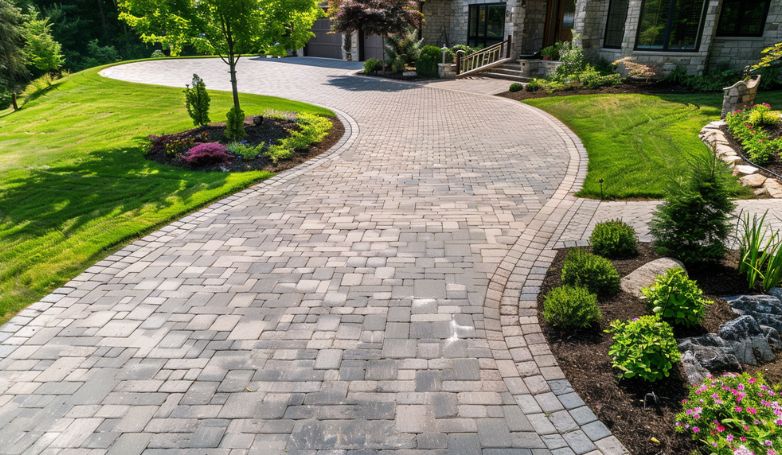
The S-shaped driveway is a dynamic choice that adds visual interest and appeal to the property. Ideal for larger estates, this design provides a longer driveway that gently curves, creating a scenic approach to the home.
The shape is perfect for navigating around existing landscaping features, offering a visually pleasing and functional driveway solution. An S-shaped driveway can also slow down incoming traffic, making the entrance safer and more serene.
8. Y Shaped Driveway
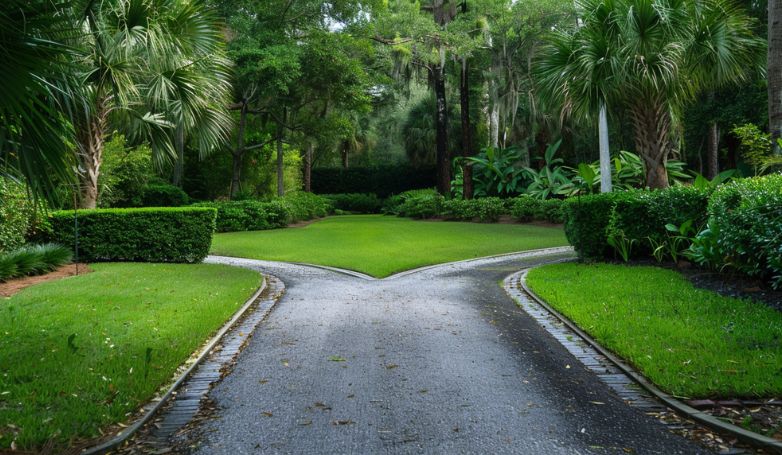
The Y-shaped driveway is an excellent solution for properties with multiple buildings or access needs. It branches off to different sections, allowing for efficient distribution of vehicles to various areas of the property. This driveway shape enhances the property’s functionality by providing separate access points, which can be particularly beneficial for guest parking or service areas.
The Y-shape also offers unique landscaping opportunities, dividing the yard into distinct zones for varied uses or themes.
9. Wide Driveway
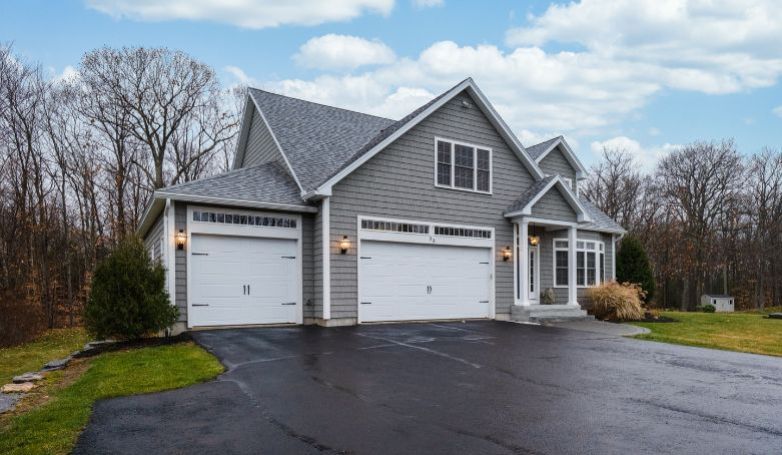
A wide driveway provides substantial benefits, particularly for households with multiple vehicles. This shape offers ample space for parking, maneuvering, and even playing sports or other activities.
Wide driveways can accommodate more than one vehicle side by side, reducing congestion and improving accessibility. Additionally, a wide driveway can significantly enhance the property’s curb appeal, creating a grand entrance that complements the home’s architectural style.
10. Serpentine Driveway
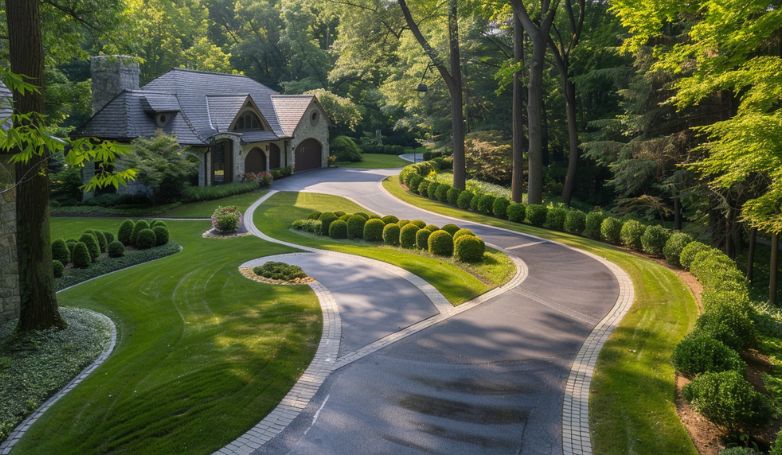
The serpentine driveway, with its winding path, offers an elegant and intriguing approach to the home. This design is perfect for long driveways, providing a visually engaging experience as it snakes through the landscape.
Serpentine driveways can slow down traffic, enhancing safety and allowing visitors to appreciate the property’s scenery. This driveway shape is ideal for estates with extensive grounds, offering a sophisticated and memorable entrance.
11. Teardrop Driveway
The teardrop driveway features a circular turnaround area, providing ease of vehicle movement and an attractive design element. This shape is especially useful for properties with limited space for turning or those seeking to minimize the need for reversing. The central island of the teardrop can be landscaped beautifully, serving as a focal point and adding to the overall aesthetic of the property. Teardrop driveways combine functionality with design elegance, making them a popular choice for homeowners looking to enhance their property’s appeal and usability.
Pros and Cons Visualized
| Shape | Pros | Cons | Cost |
| Straight | Direct path Lower construction costs Easy maintenance | Basic, less curb appeal | Generally lower due to simplicity |
| Curved | Elegant design Can navigate around obstacles | More complex to design and construct | Higher than straight, due to complexity |
| Circular (Loop) | Easy entry and exit High curb appeal | Requires significant space | High, due to size and complexity |
| Semi-Circular | Less space than full circular Enhances frontage | Still requires considerable space | Moderate to high, depending on size |
| U-Shaped | Efficient traffic flow Ample parking and turning space | Requires large front yard | High, due to larger covered area |
| L-Shaped | Good for corner lots Separates pedestrian and vehicle paths | May not be as visually appealing as other shapes | Moderate, varies with design complexity |
| S-Shaped | Visually appealing Slows down traffic | Best suited for larger properties | High, due to length and design complexity |
| Y-Shaped | Efficient for multiple buildings Unique landscaping opportunities | Can be complex to design | High, depending on branches and overall size |
| Wide | Ample space for parking/maneuvering Reduces congestion | Requires more materials, increasing costs | Higher, due to increased material use |
| Custom | Tailored to specific needs Complete creative control | Potentially high cost due to customization | Varies widely, generally higher |
| Serpentine | Elegant, memorable entrance Enhances safety by slowing down traffic | Requires long driveway length | High, due to length and landscape integration |
| Teardrop | Minimizes need for reversing Attractive landscaping focal point | Limited space efficiency | Moderate to high, depending on design details |
This table provides a high-level overview for comparison. For accurate cost estimates and design considerations specific to your property, consulting with a paving or landscaping professional is recommended. They can offer tailored advice based on your property’s unique characteristics and your personal preferences.
Considerations for Choosing the Right Driveway Shape
Selecting the ideal driveway shape requires careful consideration of various factors to ensure it complements your property’s aesthetics, meets functional needs, and stays within budget.
Space and Size
The available space and size of your property play crucial roles in determining the feasible driveway shapes. Larger areas can accommodate elaborate designs like circular or serpentine driveways, which might not be possible in tighter spaces. Straight or L-shaped driveways could be more suitable for smaller properties, offering simplicity and efficient use of limited space.
Landscape and Topography
The natural landscape and topography of your property can greatly influence your driveway shape choice. Curved or S-shaped driveways can gracefully navigate around natural obstacles like trees or slopes, integrating seamlessly with the landscape. In contrast, flat terrains offer more flexibility, allowing for a wider range of shapes including circular or wide driveways.
Usage Needs
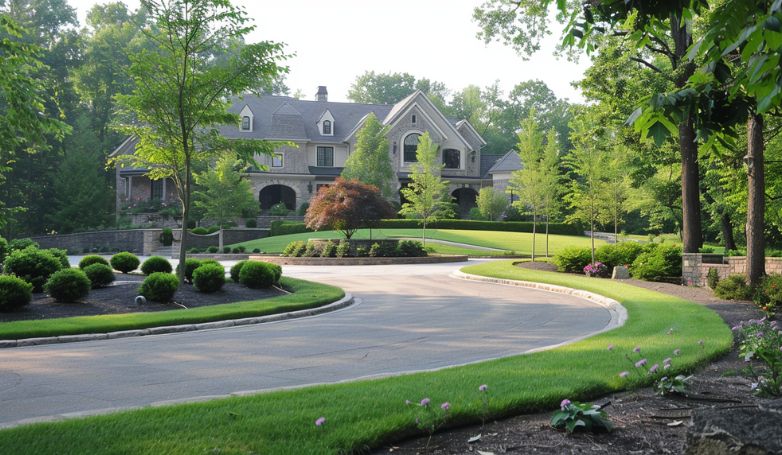
Consider how the driveway will be used daily. Families with multiple vehicles may benefit from a wide or U-shaped driveway for easier access and parking. If you frequently receive visitors, a circular driveway could provide the necessary space for smooth entry and exit. For commercial properties, a straight driveway might suffice for straightforward access.
Aesthetic Goals
Your driveway is an extension of your home’s curb appeal. If you’re aiming for a dramatic entrance, circular or serpentine driveways can make a statement. For a minimalist and modern look, straight or L-shaped driveways might be preferable. Custom driveways offer the most flexibility for matching your aesthetic vision exactly.
Budget Constraints
Budget is a significant factor in choosing a driveway shape. Straight driveways are generally the most cost-effective, while circular, serpentine, and custom shapes can be more expensive due to their complexity and the additional materials required. Assess your budget early in the planning process to determine which shapes are financially feasible for your project.
Pros and Cons of Various Driveway Shapes
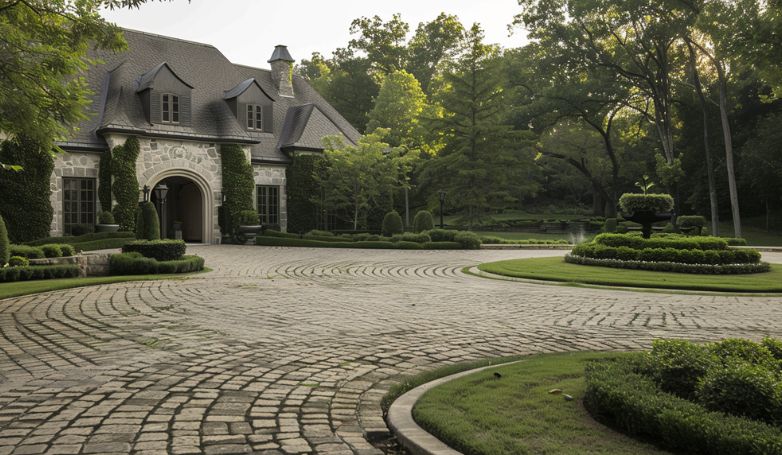
Exploring the various driveway shapes can significantly impact both the functionality and aesthetic of your property. Let’s delve into the pros and cons associated with some popular designs.
Pros and Cons of Straight Driveways
- Pros: Straight driveways offer simplicity and cost-effectiveness, making them a practical choice for many homeowners. They require less land, making them suitable for properties with limited space. Their straightforward design also simplifies construction and maintenance.
- Cons: While efficient, straight driveways may lack visual appeal and uniqueness. They offer little in terms of landscape integration and may not make the strong design statement that some homeowners desire.
Curved Driveways: Enhancing Beauty with Complexity
- Pros: Curved driveways add an element of sophistication and beauty to a property, gracefully winding through the landscape. They are ideal for navigating around natural features or obstacles, enhancing the property’s overall aesthetics.
- Cons: The complexity of designing and constructing a curved driveway can lead to higher costs. Additionally, their shape may require more land, making them less suitable for smaller properties.
Circular Driveways: Elegance and Space Use
- Pros: Circular driveways provide an elegant and grand entrance, significantly boosting curb appeal. They facilitate easy vehicle movement, allowing for smooth entry and exit without the need for reversing.
- Cons: A major drawback is the substantial space requirement, which may not be feasible for smaller properties. Additionally, circular driveways can be more expensive to install due to their size and complexity.
U-Shaped and L-Shaped: Functional Flexibility
- Pros: Both U-shaped and L-shaped driveways offer great flexibility in design and use, accommodating multiple vehicles and improving traffic flow on the property. These shapes allow for creative landscaping opportunities and can enhance the functionality of a property’s entrance.
- Cons: These designs may require more space than straight driveways, potentially increasing the cost of materials and construction. The shape may also dictate the landscaping and design of the surrounding area, requiring careful planning to achieve the desired aesthetic.
Enhancing Driveway Shapes Design with Additional Features
Incorporating additional features into your driveway design can significantly elevate its appearance and functionality. Let’s explore how landscaping, lighting, and borders can enhance various driveway shapes.
Landscaping
Landscaping around your driveway can transform it from a mere functional space into a stunning visual element of your property. For straight driveways, lining the sides with flower beds or shrubs can add color and life. Curved and circular driveways benefit from strategic planting that complements their shape, guiding the eye and integrating the driveway into the overall landscape. Trees can create a dramatic entrance or provide shade, while ground cover plants can fill in gaps and soften hard edges, making the driveway an integral part of your garden.
Lighting
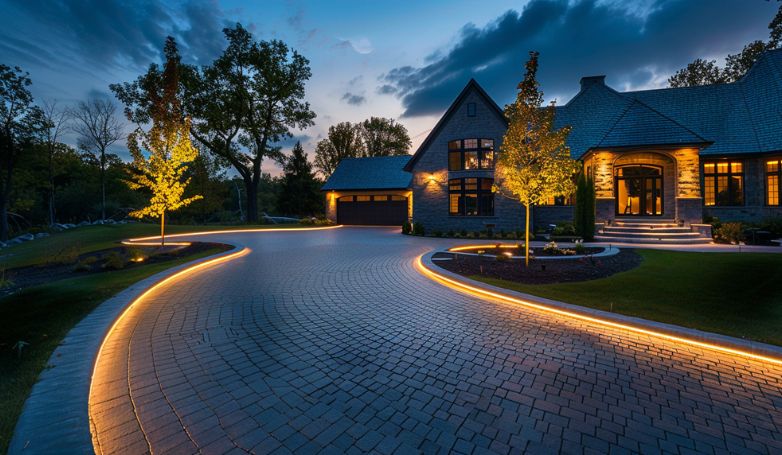
Lighting is not only a practical addition for safety and visibility at night but also an opportunity to accentuate your driveway’s best features. For straight driveways, uniform lighting can highlight the path’s directness, while for curved or circular driveways, lighting can emphasize the elegant shapes and turns. Strategically placed lights can create intriguing shadows and silhouettes, adding depth and interest. Whether using in-ground lights, lanterns, or modern LED strips, lighting options can cater to any driveway design, enhancing its appeal day and night.
Borders
Borders serve both a functional and aesthetic purpose, defining the driveway’s edges and contributing to the overall design. They can be made from a variety of materials, including brick, stone, or concrete, and can complement or contrast with the driveway material for added visual interest. Borders can also help to contain gravel or other loose driveway materials, maintaining the neatness and durability of the surface.
Together, these features can significantly enhance the visual appeal and functionality of your driveway, turning it into a cohesive element of your property’s landscape design.
Different Driveway Shapes Installation Insights
Choosing the right driveway shape involves more than just aesthetics; it also encompasses preparation, technique, and overcoming specific challenges. Let’s delve into insights on installing various driveway shapes.
Preparing Your Property for Driveway Installation
Proper preparation is key to ensuring a smooth driveway installation process. This involves clearing the designated area of any debris, vegetation, or obstacles that could hinder construction. Additionally, assessing the ground for any potential issues, such as uneven terrain or poor drainage, is crucial. Addressing these factors beforehand can prevent future complications and ensure the longevity of your driveway.
Navigating Challenges with a Curved and Circular Driveway

Curved and circular driveways present unique challenges, primarily due to their intricate shapes and the precision required in their layout. Accurate measurement and careful planning are essential to achieve the desired curvature without compromising the driveway’s functionality. This might involve using flexible materials or custom-cut pieces to accommodate the curves, ensuring a seamless and aesthetically pleasing result.
Techniques for Perfecting a Straight and L-Shaped Driveway
Achieving perfection with straight and L-shaped driveways relies on maintaining precise alignments and ensuring a level base. Utilizing string lines or lasers can help keep edges straight and angles sharp. Proper compaction of the base material is also crucial to prevent settling or shifting, which can lead to cracks or uneven surfaces over time.
Incorporating Unique Features into a U-Shaped Driveway
A U-shaped driveway offers ample opportunity for incorporating unique features that enhance both its functionality and appeal. This can include adding a central garden or water feature, which becomes a focal point, or integrating turnaround areas for easier navigation. Choosing complementary materials and landscaping can further personalize the space, making it not just a driveway but a standout feature of your property.
Driveway shapes cost analysis
Understanding the cost implications of different driveway shapes is crucial for homeowners looking to balance aesthetics, functionality, and budget in their landscaping projects.
Straight Driveway: Budget-Friendly Choice
Straight driveways are the most economical option, offering a straightforward design that minimizes materials and labor costs. Their simplicity allows for a quick installation process, making them an ideal choice for homeowners seeking efficiency and cost-effectiveness.
Curved Driveway: Price for Aesthetic Appeal
Curved driveways, while more aesthetically pleasing, come with higher costs due to their complexity. The additional labor and materials needed to achieve the desired curves can increase the overall price, making it a choice for those willing to invest more for beauty.
Circular Driveway: Investment in Elegance
Circular driveways represent a significant investment, attributed to their grand appearance and the substantial amount of materials required. Their installation is labor-intensive, reflecting in a higher cost that pays off in unparalleled curb appeal and property value enhancement.
U Shaped and L Shaped: Cost vs. Functionality
U-shaped and L-shaped driveways offer a balance between functionality and cost. These designs require more space and materials than straight driveways but provide added convenience and accessibility. The costs are justified by the improved traffic flow and additional parking space they offer.
Maintenance Tips for Different Driveway Shapes
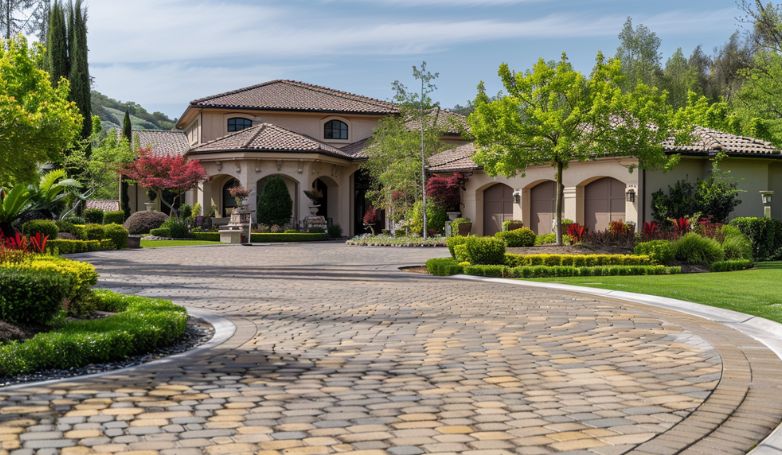
Maintaining your driveway in top condition requires understanding the specific needs of its shape and structure. Here are some tailored tips to help keep your driveway functional and aesthetically pleasing for years to come.
Routine Care for Straight and Curved Driveways
Straight and curved driveways benefit greatly from regular cleaning and the removal of weeds. For straight driveways, ensure that the path is clear of debris to prevent surface damage. Curved driveways might require more attention to detail, especially along the curves, to prevent the accumulation of leaves and dirt that can lead to discoloration and surface wear.
Addressing Wear and Tear on Circular and U Shaped Driveways
Circular and U-shaped driveways, often experiencing high traffic, require frequent inspections for cracks or potholes. Early detection and repair of such damages are crucial to prevent further deterioration. Consider applying a fresh layer of sealant every few years to protect the surface against weathering and stains.
Preventative Measures for L Shaped Driveways
For L-shaped driveways, focus on preventing drainage issues that can lead to water damage. Ensure that the driveway is graded correctly to direct water away from the property. Regularly cleaning the gutters and downspouts can also prevent water accumulation, which is critical for L-shaped driveways where water can pool in the corner.
Enhancing Durability with Sealants and Coatings
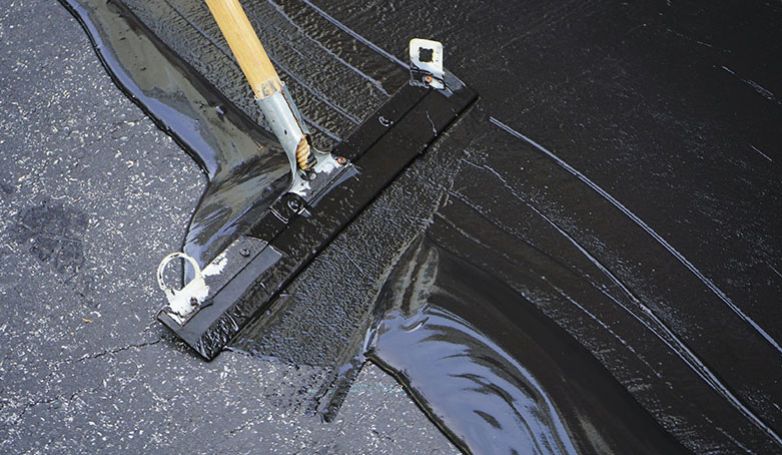
Applying sealants and protective coatings is an effective way to enhance the durability of any driveway shape. These products provide a barrier against UV rays, rain, oil, and other substances that can damage the driveway surface. Reapply as recommended by the manufacturer to maintain the driveway’s integrity and appearance, regardless of its shape.
FAQs about Driveway Shapes
Check out the most frequently asked questions:
Which are the best driveway shapes?
The best driveway shape depends on your property’s size, landscape, and personal preferences. Straight driveways suit minimalist designs, while curved, circular, or U-shaped driveways enhance larger properties with aesthetic appeal.
How do you design a driveway layout?
Designing a driveway layout involves assessing your property’s topography, the house’s location, and desired traffic flow. Consider using design software or consulting with a professional to integrate the driveway seamlessly with your landscape and architecture.
Should the driveway be straight or curved?
Choosing between a straight or curved driveway depends on your property’s layout and aesthetic goals. Straight driveways fit well with modern, minimalist landscapes, while curved driveways can navigate around natural features and add visual interest.
How Do Driveway Shapes Impact the Overall Design of a Property?
Driveway shapes significantly impact a property’s curb appeal and functionality. The right shape can complement the house’s architecture, improve traffic flow, and enhance the landscape, making the driveway a key component of the property’s overall design.
Conclusion
In choosing the right driveway shapes, you’re not just selecting a pathway to your home; you’re enhancing its aesthetic appeal, functionality, and overall value. From the simplicity of straight designs to the elegance of curved, circular, U-shaped, or L-shaped options, each driveway shape brings its unique benefits and considerations. By evaluating your property’s layout, your style, and functional requirements, you can identify the driveway shape that best enhances your home’s exterior. Opting for the ideal driveway shape can dramatically elevate your property’s charm and practicality.

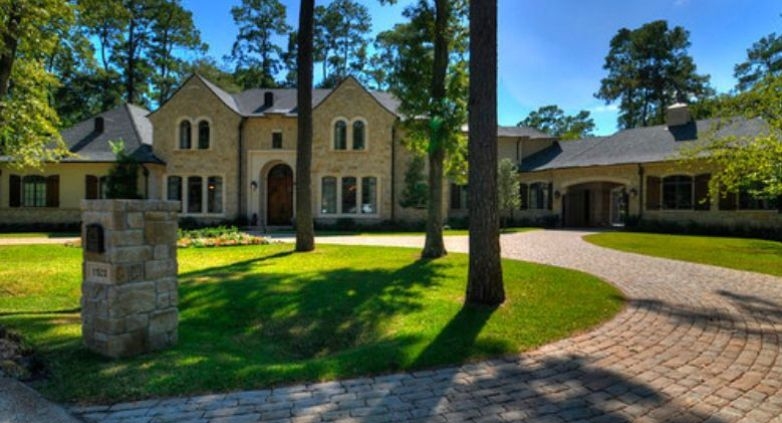

Leave a Reply
Want to join the discussion?Feel free to contribute!